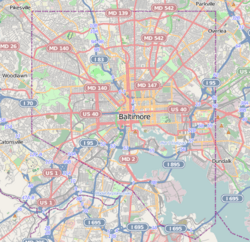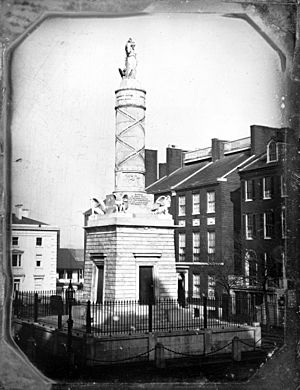Battle Monument facts for kids
Quick facts for kids |
|
|
Battle Monument
|
|

Battle Monument, Baltimore, October 2011
|
|
| Location | Calvert St. between Fayette and Lexington Sts., Baltimore, Maryland |
|---|---|
| Area | 1 acre (0.40 ha) |
| Built | 1815 |
| Architect | Godefroy, J. Maximillian M.; Capellano, Antonio (crowning statue sculpture) |
| NRHP reference No. | 73002181 |
| Added to NRHP | June 4, 1973 |
The Battle Monument stands in Battle Monument Square in Baltimore, Maryland. It remembers the brave people who fought and died in September 1814 during the War of 1812. This war was fought between the United States and Great Britain.
The monument honors those who defended Baltimore during the Battle of Baltimore. This included the British navy's attack on Fort McHenry. It also remembers the fighting at Battle of North Point and the defense lines at Hampstead Hill (now Patterson Park). The city of Baltimore and a group called the "Committee of Vigilance and Safety" helped create it.
Contents
The Battle Monument: Honoring Heroes
The Battle Monument is a special landmark in Baltimore. It is located right in the middle of North Calvert Street. It stands between two important courthouses. This monument was built to honor the heroes of the War of 1812.
Why Was it Built Here?
The spot where the Battle Monument stands was once planned for a different monument. It was supposed to be the location for the Washington Monument. That monument honors America's first president, George Washington.
The first stone for the Washington Monument was laid on July 4, 1815. But people worried that its tall design might fall over onto nearby houses. So, the Washington Monument was moved further north. The Battle Monument then took its place in the city center.
Design and Meaning
The Battle Monument was designed by architect J. Maximilian M. Godefroy. It was built between 1815 and 1825. The monument is about 39 feet (11.9 meters) tall.
The bottom part of the monument looks like an ancient Egyptian tomb. It is special because it lists the names of everyone who died. This includes soldiers of all ranks, which was unusual for monuments at that time.
The base has eighteen layers of marble. These layers represent the eighteen states that were part of the United States during the war. There is a mythical creature called a griffin at each corner of the base.
The main column looks like a Roman fasces. This is a bundle of rods tied together. The names of the soldiers who died are carved into the cords that wrap around the column. The names of the officers who died are listed at the very top.
Lady Baltimore Statue
On top of the monument is a large statue. It is 8 feet tall and weighs 2,750 pounds. This statue is made of white Carrara marble. It was created by Antonio Capellano.
The statue shows a female figure. She represents the city of Baltimore. She wears a crown of victory. In one hand, she holds a laurel wreath, a symbol of triumph. In her other hand, she holds a ship's rudder, which guides a ship.
People often call this statue Lady Baltimore. It was placed on top of the monument on September 12, 1822. This was the eighth anniversary of the Battle of Baltimore. In 2013, the original statue was moved to the Maryland Center for History and Culture. This was done to protect it from weather damage. A strong concrete copy now stands in its place. The Battle Monument is the oldest stone monument in the United States that honors a war.
A City Symbol
The Battle Monument is a very important symbol for Baltimore. It is shown on the official seal of the City of Baltimore. This seal was adopted in 1827. The monument also appears on the city's flag, which was adopted in the early 1900s.
In Pop Culture
Sometimes, monuments appear in movies. In the 2007 film Live Free or Die Hard, the Battle Monument is shown. However, the movie incorrectly shows it as being in Washington, D.C.. Many parts of that movie were actually filmed in downtown Baltimore.
A National Treasure
The Battle Monument is recognized as an important historical site. It was added to the National Register of Historic Places on June 4, 1973. It is also part of the Baltimore National Heritage Area.





